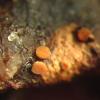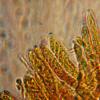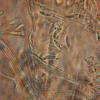
07-12-2025 16:07
Arnold BüschlenHallo, ich habe in einer Moos-Aufsammlung (epiphy

08-12-2025 21:04
Mark Stevens"Hello everyone,I'm relatively new to microscopy (

09-12-2025 12:06
 Andgelo Mombert
Andgelo Mombert
Bonjour,Je recherche l'article concernant Hypobryo

08-12-2025 18:59
 Lothar Krieglsteiner
Lothar Krieglsteiner
.. found by a seminar-participant, I do not know t

08-12-2025 17:37
 Lothar Krieglsteiner
Lothar Krieglsteiner
20.6.25, on branch of Abies infected and thickened

16-03-2014 22:00
Hello,I found this species a few months ago but ha

08-12-2025 13:39
Thomas Læssøehttps://svampe.databasen.org/observations/10572899

Dear friends!
Do you have some idea about the genus of this tiny disco?
I have found it on dead leaves of Quercus robur. Fruitbodies are single, small, orange-beige, 0,2-0,5 mm in diam.
I thought about Pezicula, but apical rings are blued in IKI (colourless in MLZ)
Spores are ellipsoid, 10,9-11,4*2,4-3,6 um, hyaline, with 2-3 guttules (in water, KOH).
Thank you before,
Irina

Raúl

Yes, that might be right guess....it seems to me that asci are of Calycina type reaction (although there are number of genera apart from Calycina with that type of euamyloid reaction). Perhaps a drawing of some cell types, most preferably in statu vivo (see Baral 1992 publ. in Mycotaxon, which I can send if still needed) and observation on paraphysal & excipular layer(s) structure & gelification would be sufficiently informative. Also ascogenous system type (croziers vs. simple septate) is crucial. it is not necessary to draw whole block of texture(s) or hymenia - only group of cells.
Cordially,
Neven



